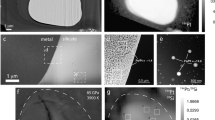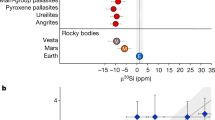Abstract
The Moon accreted meteoritic material towards the end of Solar System formation. Quantification of this late accretion requires an estimation of the abundance of highly siderophile, or iron-loving, elements in the lunar mantle. As lunar mantle samples are not available, estimates are derived from lunar basalt compositions, but the melting phase relations needed to derive the mantle composition are poorly constrained. Here we present sulfur solubility measurements from laboratory experiments, combined with thermodynamic calculations, which show that the lunar basalt source is likely to be saturated in a sulfur-poor, iron-rich sulfide melt that concentrates some highly siderophile elements more than others. We found that the observed range in the ratios of highly siderophile elements in primitive lunar basalts is much smaller than expected from residual sulfide control alone. Instead, the elemental ratios are consistent with mixing between primary sulfide-saturated melts and minute (<1%) amounts of lunar regolith that contain impact debris. Although the composition of some samples suggests a highly depleted lunar mantle, the exact level of depletion is unclear, because mixing trajectories overlap at the inferred level of regolith contamination. We conclude that the composition of the lunar mantle is veiled by regolith contamination of the lunar basalts. If so, highly siderophile element abundances in lunar mantle-derived materials cannot be used to determine the mass of material accreted late onto the Moon.
This is a preview of subscription content, access via your institution
Access options
Access Nature and 54 other Nature Portfolio journals
Get Nature+, our best-value online-access subscription
$29.99 / 30 days
cancel any time
Subscribe to this journal
Receive 12 print issues and online access
$259.00 per year
only $21.58 per issue
Buy this article
- Purchase on Springer Link
- Instant access to full article PDF
Prices may be subject to local taxes which are calculated during checkout




Similar content being viewed by others
Data availability
The authors declare that the data supporting the findings of this study are available within the paper and its Supplementary Information files.
References
Day, J. M. D., Pearson, D. G. & Taylor, L. A. Highly siderophile element constraints on accretion and differentiation of the Earth–Moon system. Science 315, 217–219 (2007).
Becker, H. et al. Highly siderophile element composition of the Earth’s primitive upper mantle: constraints from new data on peridotite massifs and xenoliths. Geochim. Cosmochim. Acta 70, 4528–4550 (2006).
Walker, R. J., Horan, M. F., Shearer, C. K. & Papike, J. J. Low abundances of highly siderophile elements in the lunar mantle: evidence for prolonged late accretion. Earth Planet. Sci. Lett. 224, 399–413 (2004).
Morgan, J. W., Walker, R. J., Brandon, A. D. & Horan, M. F. Siderophile elements in Earth’s upper mantle and lunar breccias: data synthesis suggests manifestations of the same late influx. Meteorit. Planet. Sci. 36, 1257–1275 (2001).
Bottke, W. F., Levison, H. F., Nesvorny, D. & Dones, L. Can planetesimals left over from terrestrial planet formation produce the lunar Late Heavy Bombardment? Icarus 190, 203–223 (2007).
Nesvorny, D. et al. Cometary origin of the zodiacal cloud and carbonaceous meteorites: implications for hot debris disks. Astrophys. J. 713, 816–836 (2012).
Schlichting, H. E., Warren, P. H. & Yin, Q.-Z. The last stages of terrestrial planet formation: dynamical friction and the late veneer. Astrophys. J. 752, 1–8 (2012).
Bottke, W. F., Walker, R. J., Day, J. M. D., Nesvorny, D. & Elkins-Tanton, L. Stochastic late accretion to Earth, the Moon, and Mars. Science 330, 1527–1530 (2010).
Raymond, S. N., Schlichting, H. E., Hersant, F. & Selsis, F. Dynamical and collisional constraints on a stochastic late veneer on the terrestrial planets. Icarus 226, 671–681 (2013).
Hauri, E. H., Saal, A. E., Rutherford, M. C. & Van Orman, J. A. Water in the Moon’s interior: truth and consequences. Earth Planet. Sci. Lett. 409, 252–264 (2015).
Sharp, Z. D., Shearer, C. K., McKeegan, K. D., Barned, J. D. & Wang, Y. Q. The chlorine isotope composition of the Moon and implications for an anhydrous mantle. Science 329, 1050–1053 (2010).
McCubbin, F. et al. Magmatic volatiles (H, C, N, F, S, Cl) in the lunar mantle, crust, and regolith: abundances, distributions, processes, and reservoirs. Am. Miner. 100, 1668–1707 (2015).
Mungall, J. E. & Brenan, J. M. Partitioning of platinum-group elements and Au between sulfide liquid and basalt and the origins of mantle–crust fractionation of the chalcophile elements. Geochim. Cosmochim. Acta 125, 265–289 (2014).
Ding, S., Hough, T. & Dasgupta, R. New high pressure experiments on sulfide saturation of high-FeO* basalts with variable TiO2 contents—implications for the sulfur inventory of the lunar interior. Geochim. Cosmochim. Acta 222, 319–339 (2018).
Steenstra, E. S. et al. Evidence for a sulfur-undersaturated lunar interior from the solubility of sulfur in lunar melts and sulfide–silicate partitioning of siderophile elements. Geochim. Cosmochim. Acta 231, 130–156 (2018).
Wadhwa, M. Redox conditions on small bodies, the Moon and Mars. Rev. Mineral. Geochem. 68, 493–510 (2008).
Green, D. H., Ware, N. G., Hibberson, W. O. & Major, A. Experimental petrology of Apollo 12 basalts. Part 1, sample 12009. Earth Planet. Sci. Lett. 13, 85–96 (1971).
Papike, J. J., Fowler, G. W., Adcock, C. T. & Shearer, C. K. Systematics of Ni and Co in olivine from planetary melt systems: lunar mare basalts. Am. Mineral. 84, 392–399 (1999).
O’Neill, H. St C. & Mavrogenes, J. A. The sulfide capacity and sulfur content at sulfide saturation of silicate melts at 1,400 °C and 1 bar. J. Petrol. 43, 1049–1087 (2002).
Jugo, P. J., Wilke, M. & Botcharnikov, R. E. Sulfur K-edge XANES analysis of natural and synthetic basaltic glasses: implications for S speciation and S content as function of oxygen fugacity. Geochim. Cosmochim. Acta 74, 5926–5938 (2010).
Buono, A. S. & Walker, D. The Fe-rich liquidus in the Fe–FeS system from 1 bar to 10 GPa. Geochim. Cosmochim. Acta 75, 2072–2087 (2011).
Holzheid, A., Palme, H. & Chakraborty, S. The activities of NiO, CoO and FeO in silicate melts. Chem. Geol. 139, 21–38 (1997).
Bombardieri, D. J., Norman, M. D., Kamenetsky, V. S. & Danyushevsky, L. V. Major element and primary sulfur concentrations in Apollo 12 mare basalts: the view from melt inclusions. Meteorit. Planet. Sci. 40, 679–693 (2005).
Chen, Y. et al. Water, fluorine, and sulfur concentrations in the lunar mantle. Earth Planet. Sci. Lett. 427, 37–46 (2015).
Hauri, E. H., Weinreich, T., Saal, A. E., Rutherford, M. C. & Van Orman, J. A. High pre-eruptive water contents preserved in lunar melt inclusions. Science 333, 213–215 (2011).
Saal, A. E. et al. Volatile content of lunar volcanic glasses and the presence of water in the Moon’s interior. Nature 454, 192–195 (2008).
Wing, B. A. & Farquhar, J. Sulfur isotope homogeneity of lunar mare basalts. Geochim. Cosmochim. Acta 170, 266–280 (2015).
Elkins-Tanton, L. T. Magmatic processes that produced lunar fire fountains. Geophys. Res. Lett. 30, 1513 (2003).
Asimow, P. D. & Longhi, J. The significance of multiple saturation points in the context of polybaric near-fractional melting. J. Petrol. 45, 2349–2367 (2004).
Smythe, D. J., Wood, B. J. & Kiseeva, E. S. The S content of silicate melts at sulfide saturation: new experiments and a model incorporating the effects of sulfide composition. Am. Min. 102, 795–803 (2017).
Fonseca, R. O. C., Mallmann, G., O’Neill, H. St C. & Campbell, I. How chalcophile is rhenium? An experimental study of the solubility of Re in sulphide mattes. Earth Planet. Sci. Lett. 260, 537–548 (2007).
Brenan, J. M. Re–Os fractionation by sulfide–silicate partitioning: a new spin. Chem. Geol. 248, 140–165 (2008).
Hallis, L. J., Anand, M. & Strekopytov, S. Trace-element modelling of mare basalt parental melts: implications for a heterogeneous lunar mantle. Geochim. Cosmochim. Acta 134, 289–316 (2014).
Day, J. M. D., Walker, R. J., James, O. B. & Puchtel, I. S. Osmium isotope and highly siderophile element systematics of the lunar crust. Earth Planet. Sci. Lett. 289, 595–605 (2010).
Morbidelli, A. et al. The timeline of the lunar bombardment: revisited. Icarus 305, 262–276 (2018).
Day, J. M. D. & Walker, R. J. Highly siderophile element depletion in the Moon. Earth Planet. Sci. Lett. 423, 114–124 (2015).
Puchtel, I. S., Walker, R. J., James, O. B. & Kring, D. A. Osmium isotope and highly siderophile element systematics of lunar impact melt breccias: implications for the late accretion history of the Moon and Earth. Geochim. Cosmochim. Acta 72, 3022–3042 (2008).
Liu, J., Sharp, M., Ash, R. D., Kring, D. A. & Walker, R. J. Diverse impactors in Apollo 15 and 16 impact melt rocks: evidence from osmium isotopes and highly siderophile elements. Geochim. Cosmochim. Acta 155, 122–153 (2015).
Gleißner, P. & Becker, H. Formation of Apollo 16 impactites and the composition of late accreted material: constraints from Os isotopes, highly siderophile elements and sulfur abundances. Geochim. Cosmochim. Acta 200, 1–24 (2017).
Horan, M. F., Walker, R. J., Morgan, J. W., Grossman, J. N. & Rubin, A. E. Highly siderophile elements in chondrites. Chem. Geol. 196, 5–20 (2003).
Sharma, R. C. & Chang, Y. A. Thermodynamics and phase relationships of transition metal–sulfur systems. Part III. Thermodynamic properties of the Fe–S liquid phase and the calculation of the Fe–S phase diagram. Metall. Trans. B 10, 103–108 (1997).
Woodland, A. B. &. O’Neill, H. St C. Thermodynamic data for Fe-bearing phases using noble metal redox sensors. Geochim. Cosmochim. Acta 61, 4359–4366 (1997).
Bennett, N., Brenan, J. M. & Fei, Y. Metal-silicate partitioning experiments at high pressures and temperatures: experimental methods and a protocol for suppressing highly siderophile element inclusions. J. Vis. Exp. 100, e52725 (2015).
Eggins, S. M., Kinsley, L. P. J. & Shelley, J. M. M. Deposition and element fractionation processes during atmospheric pressure laser sampling for analysis by ICPMS. Appl. Surf. Sci. 127-129, 278–286 (1998).
Pearce, N. J. G. et al. A compilation of new and published major and trace element data for NIST SRM 610 and NIST SRM 612 glass reference materials. Geostand. News 21, 115–144 (1997).
Walker, R. J. et al. Modeling fractional crystallization of Group IVB iron meteorites. Geochim. Cosmochim. Acta 72, 2198–2216 (2008).
Thompson, J. B. Jr. Thermodynamic properties of simple solutions. Adv. Geochem. 2, 340–361 (1967).
Acknowledgements
J.M.B. and J.E.M. acknowledge financial support from the Natural Sciences and Engineering Research Council of Canada through the Discovery Grant Program. V. Homolova is thanked for her assistance in conducting some of the sulfide solubility experiments when an undergraduate student at University of Toronto. We especially appreciate the detailed comments from R. Fonseca and P. Gleißner.
Author information
Authors and Affiliations
Contributions
J.M.B. conceived of the study. J.M.B. did the experiments and run-product analysis. J.E.M. did the melting calculations with input from J.M.B. N.R.B. provided the sulfide melt speciation model. J.M.B. wrote the manuscript with input from J.E.M. and N.R.B.
Corresponding author
Ethics declarations
Competing interests
The authors declare no competing interests.
Additional information
Publisher’s note: Springer Nature remains neutral with regard to jurisdictional claims in published maps and institutional affiliations.
Supplementary information
Supplementary Information
Supplementary Information and Figs. 1–13.
Supplementary Table 1
Summary of silicate and sulfide melt compositions from sulfur solubility experiments.
Supplementary Table 2
Summary of phase compositions from sulfide–silicate partitioning experiments.
Supplementary Table 3
Summary partition coefficients.
Supplementary Table 4
Parameters used for melting and crystallization calculations.
Supplementary Table 5
Summary of mixing parameters for tungsten isotopes.
Rights and permissions
About this article
Cite this article
Brenan, J.M., Mungall, J.E. & Bennett, N.R. Abundance of highly siderophile elements in lunar basalts controlled by iron sulfide melt. Nat. Geosci. 12, 701–706 (2019). https://doi.org/10.1038/s41561-019-0426-3
Received:
Accepted:
Published:
Issue Date:
DOI: https://doi.org/10.1038/s41561-019-0426-3
This article is cited by
-
Reply to: No 182W evidence for early Moon formation
Nature Geoscience (2021)
-
No 182W evidence for early Moon formation
Nature Geoscience (2021)
-
The Earth–Moon late-accretion conundrum
Nature Geoscience (2019)



